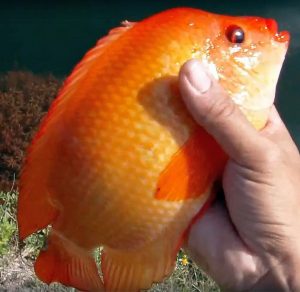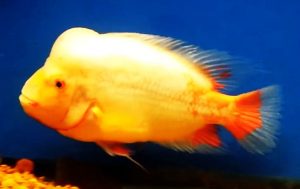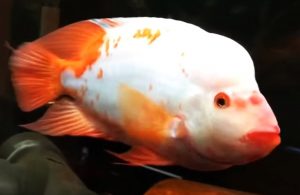The Red Devil Cichlid (Amphilophus labiatus) is a large Central American species that is usually found in submerged rocky areas hiding among the crevices in Lake Managua and Lake Nicaragua.
Tropical fish keeping enthusiasts will readily attest that the Red Devil Cichlid is one of the most aggressive cichlids around, bar none. Keeping a single male can only be done safely in a large single species tank, regardless of size.
Red Devil Cichlids are often confused with the Midas Cichlid (Amphilophus citrinellus). Wild Red Devil cichlids have large lips, smaller nuchal humps, and are less “stocky” than Amphilophus citrinellus.
Because of hybridization by tropical fish keeping enthusiasts to achieve different colors and patterns, pure bred specimens of either species are becoming increasingly difficult to obtain.
Although the majority of wild caught Red Devil Cichlids are a nondescript gray color, a few wild specimens have an orange or red color pattern.
These fish have been selectively bred to produce different color patterns for the aquarium trade including, grey, yellow, orange, red, white, barred, and piebald forms.
Mature male Red Devil Cichlids are larger, stockier, and develop longer dorsal and anal fins than females. The nuchal humps that develop during the breeding season in their natural environment is larger and more spectacular in males than in females. Aquarium bred specimens often posses large permanent humps that demand higher prices.
Because of their viscous temperament, Amphilophus labiatus are best kept in a single species aquarium of at least 80 gallon capacity with a sand and large gravel substrate, some large river rocks constructed into caves, a large flowerpot, and some large driftwood branches. Plants are not recommended as they will be quickly dug up and shredded.
Because of their greedy, messy feeding habits, Red Devil cichlids produce large amounts of biological waste. Weekly water changes are a must and a trickle filter or a large canister filter
system, along with a power head, is highly recommended to provide the clean, highly oxygenated water they require.
Be sure to protect your heaters, filters, air lines, water intakes and outlets, etc. from being attacked by the fish when they become excited or aggressive. A heavy aquarium cover is recommended to keep the fish from jumping out of the tank when they become excited or startled.
If you have the space and can afford to keep Red Devil Cichlids in a community aquarium environment, a tank of at least 300 gallons is required to minimize aggression and keep them from killing the other inhabitants.
In this setting they can be housed with large Loricariids, large catfish, other Central American cichlids, and other large fast swimming species like tinfoil barbs or silver sharks however, even in this setting, a single male may murder everything else in the tank. NEVER try keeping more than a single male in one tank regardless of size.
If you can get a compatible pair of the same species, Red Devil Cichlids are easy to breed.
A large breeding tank at least 6 feet long decorated with large rocks and several heavy flowerpots to act as potential spawning sites is needed.
The trick is to successful breeding is to keep the pair from killing each other before they breed. If the pair is placed in the tank together, the male will often kill the female. Some breeders place a clear divider in the tank until the fish get used to each other, but even then mortalities occur. Most breeders purchase 6 to 8 young specimens, wait for a pair to form, and then remove the other fish from the tank before they are murdered.
A “mated” pair will breed without any outside help. The nuchal hump in both sexes will grow larger when the fish are in spawning condition. Courtship is long, often violent, and consists of gaping, a lot of tail slapping and a lot of digging by both fish. The female will often rub her lateral line along the hump of the male.
If the male does not turn and kill the female, the female will lay her eggs in a cave, flowerpot, or any vertical rock surface in the tank. The male fertilizes the eggs which hatch in about 2 to 3 days.
Red Devil Cichlids are excellent parents and will fiercely defend the eggs and fry against all intruders, including the tropical fish keeping enthusiast should they try doing any tank maintenance. The parents move the newly hatched fry into a pit that they excavate in the substrate where they become free swimming in about 5 to 7 days.
Many breeders install a divider at this stage to keep the female from the male.
Don’t remove the fry from the tank or the male will try to spawn with the female a second time. If the female is not ready to participate, the male will often kill the female.
The free swimming fry have a barred body pattern and can be fed newly hatched brine shrimp and dried flakes. They grow very quickly under the right conditions, and will start to change color at around 2″ to 2.5″ in size.
Red Devil Cichlids are not fussy feeders and will try to eat anything that looks edible. They do well on a quality floating cichlid stick with supplemental feedings of live, frozen, or freeze dried prawn, mussels, shrimp, earthworms, peas, spinich,etc. Do not feed them red meats, beef hearts, or feeder fish.
Despite the Red Devil Cichlids (Amphilophus labiatus) nature and reputation as a killer, they are one of the most popular aquarium species. They quickly learn to recognize their owners and will intelligently interact with them. They will actually “beg” for food when their owners are recognized entering a room.
Amphilophus labiatus are readily available to tropical fish keeping enthusiasts online, from specialty fish shops, online auction sites, and cichlid forums in a wide range of sizes at reasonable prices.
Minimum Tank Size: 100 gallons
Care Level: Difficult
Temperament: Super Aggressive
Aquarium Hardiness: Hardy
Water Conditions: 69.8-78.8° F, KH 5-25, pH 6.0-8.0
Max. Size: 13”
Color Form: Gray, Orange, Red, Yellow
Diet: Omnivore
Compatibility: Single species tank
Origin: Nicaragua, Costa Rica
Family: Cichlidae
Lifespan: 10-15 years
Aquarist Experience Level: Advanced






Red Devil Cichlids (Amphilophus labiatus), Midas cichlids (Amphilophus citrinellum)and Oscars are considered an invasive species in south Florida and are caught on light tackle on a regular basis by anglers in the area.
Knife fish, snakeheads, and a variety of cichlids are also in the canal systems in the Miami to West Palm Beach area.